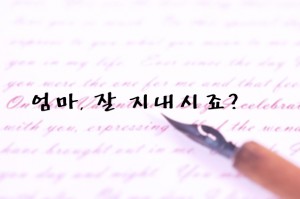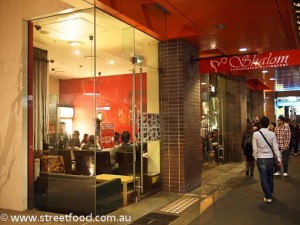Advice for the Speaking Test
The IELTS Speaking test is just like a job interview; you enter, exchange pleasantries, have a serious conversation, exchange pleasantries then leave. A job interview is to prove to the employer you deserve the job, a Speaking session is to prove you deserve a certificate. It’s purely business; you are not there to be the listener’s best friend. You need to show them you’re a serious person, you know what you want and you will do your best to win it.
Speaking isn’t just about what you say, it’s also about how you say it. You might get a question on a topic you know a lot about. This is great, but your answer won’t help you at all if people don’t understand what you’re saying. You need to get your voice to volume between whisper and shouting; in other words a moderate level. You need to keep your speed at a moderate pace; no-one (aside from friends and family) can understand you when you speak too fast. This applies to IELTS examiners. It is better to be too slow than too fast, but you will improve your chances if your speed is at a middle rate. Fluency is important; don’t give long pauses, too many pauses, or run the words together. This damages the flow of the speech. Pausing is good when you’re not sure what to say, but the time and amount of the pauses should be as low as possible. Try not to repeat sentences or standout words, this will look unoriginal. When you pronounce words, remember they do not always sound as they look.
“kn”= sounds like “n”
“h”= is silent when next to “o” sometimes. For example hour and honour. Other times it isn’t in words such as “home”, “house” and “horse”.
There is no problem if you want to use big words, fancy words, or academic words, that is a decision for you. Your marks will not go up for the words, the marks will go up because you say the words correctly. However you can still achieve good results if you give a basic answer as long as it is spoken well. Speaking is about QUALITY, NOT QUANTITY.
If you receive a speaking topic you don’t like but know about, give an answer. Don’t ask for a new set of questions just because you don’t like it or you may receive a topic you know nothing about. The test is not a knowledge test, but you will benefit if you have information on the subject. You should only change the questions if they are genuinely difficult. You should have an idea on whether a subject is too hard or not.
A good way to answer each question is to give a statement (“Yes I do”, “I’m not sure” etc) an explanation (“I did it in…”), and maybe an example (“For example when I needed to look for essay information..”). The statement and explanation are the most important parts however an example could help.
It isn’t just about what you know, it’s using what you know. Speaking is also about presenting the words, and managing the words.
-Nicholas John Gysi
The two most important things examiners are looking for for A level writing
In my years of teaching OET, I have marked many referral letters and I have found two key features that distinguishes the truly excellent writers from the not so excellent writers. The two features are 1. CLARITY and 2. ORDER.
When students write legibly, use correct spelling, punctuation, syntax, letter format, paragraphing, grammar and expression of their ideas there is CLARITY. I can not emphasis enough, though these aspects may seem minor and therefore unimportant, they are not. This is what differentiates between a winning writer and a non-A grade. Furthermore, for a marker with hundreds of papers to grade, anything to make it easier for the examiner to read is CONSIDERATE. This in turn will ultimately win the favour of your examiner over the hundreds of candidates who do not take these things into consideration.
Secondly, when students are able to organise the list of patient file information into clear paragraphs, that contain only the most relevant and grouped information, it is ORDERED. Think of it like cleaning. When you clean, you sort the socks into one pile, the shirts in another etc. In the same way, even though there maybe a whole list of medical history or presenting complaints, consider,
– if it is a lengthy chronic disease history, to place the most significant turn of events into each paragraph chronologically,
– if it is multiple disease states, to group their progression, treatment and outcomes in each paragraph per disease.
There are many other ways of ordering the body of the letter, which we teach you at OET because each patient file is so different. All in all, the most sophisticated writings are the ones where there is a logical order in which the patient’s case is depicted.
My last tip for today is that as with anything in life, begin every act with love for the other person in mind. In the case of OET, mindfulness of the circumstances and desires of the examiner. They want to read through a letter quickly and smoothly without having to stop here and there because they can not understand something. So make sure, if you have time at the end, to proof read and check that all the above mentioned is done. Clear understanding, isn’t that the core of communication?
Some Stories About Our Japanese Course 12
Hi everyone, 皆さん、こんにちは。
My Japanese classes and lessons include the usual kinds of activities that aim to develop speaking, reading, listening, writing and making and performing dialogues. Apart from the usual course book, Genki 1, I used A First Couse in Japanese (by Fudeko Reekie) and Busy People Book 2 for vocabulary concerned with time, days/dates, months and sentences that have those words. Among those, a couple of pages of Japanese for Busy People, Bk 2, pp. 60-61 are one of my favorite. They list the phrases that are commonly spoken in everyday life with the cute/friendly/neat pictures with. And they have a many different verbs used in the sentences. Their contexts are more of adults’ life, but they can be used for school students too. Especially the phrases such as “Uchi de nonbirishimasu.” (=I’ll have relaxing time at home), “Tomodachi to oshaberi o shimasu.” (=I’ll chat with my friend) are my favorite ones. I used many Japanese textbooks in the past (and did research for my academic study, but it seemed some phrases, which are commonly spoken in Japanese people’s daily life, are not in many textbooks unless the linguistic level is high. I think listing the above phrases is desirable.
Also, some of useful pages used in my classes (including tutorials or class that had students who were going to Japan soon) were: a list of many kinds of products at a department store that was on p. 136, A First Course in Japanese. The names of all sorts of products commonly seen at big department stores in Japan are written in Hiragana, Katakana and Kanji. They were very useful that is for making sentences.
Similarly, I taught dialogues at a restaurant, in some classes. That is with p. 158 and 159, of the above mentioned book. They are dialogues between a waitress/waiter and customers who wish to order food and drinks and dialogue that is spoken after the meal and for paying the bill at the restaurant. Those will be useful for people who are going to Japan for trips or for living in Japan.
In addition, I taught how to ask or answer about the departure time and arrival time of trains/bullet trains with use of the Jikoku-hyo (Train-timetable of the JTB).
Magazine Jentahad interesting articles/news and I referred to that in classes. One of them was “Enjoying Mt. Fuji”, 27 July, 12, p. 4. It talked about Mt Fuji, , surrounding of it, well known Fuji-Q Highland where I had worked for part time jobs at the skating centre and swimming pool. The above very big amusement park has fascinating facilities and not far from Tokyo.
I taught 4 ~ 5 Japanese songs to most of classes. Most of them are well known children’s songs and they have many plain forms, “many” word of onomatopoeia, sensitivity and emotions for nature or living things etc. And I think singing such songs in relaxing or uplifting music of cd with use of Hiragana based handouts is useful.
Also, I talked about the famous statue of Chuuken-hachiko that is in front of Shibuya Station, Tokyo. It was reported in The Japan Times (17.6.12, P.11). An “amazing” dog that passed away in 1935 (he saw his statue well before his death.) He was a bit similar to the Red Dog, the famous dog in Australia that was portrayed in the movie.
Japanese Teacher, Toshiko Jackson
4.9.12
Relationship talks in Korean
Are you interested in going out with Korean boys/ girls? Then read the following expressions!
Today, let’s talk about some expressions regarding relationships.
It was love at first sight. 우린 서로 첫눈에 반했어요.
Would you like to go out with me? 저랑 사귈래요?/ 나랑 사귈래?
I love you. 사랑합니다/ 사랑해요/ 사랑해
I’m crazy about you. 당신에게 반했어요.
We’re a match made in heaven. 우린 천생연분이야.
We split up. 우린 헤어졌어요.
Would you marry me? 저랑 결혼해 줄래요?/ 우리 결혼 하자.
He broke up with me. 나는 그에게 차였어요.
Good luck!
Written by Eun Kyeong Ashley Jang (Korean Teacher)
한국어 Sentence Structures
The basic structures in Korean are “Subject+predicate” or “Subject+Object+Predicate.” There is a space between the subject, object, and the predicate, and sentences end with a period.
원빈오빠가subject 가요predicate. Won Bin oppa goes.
애슐리가subject 커피를object 마셔요 predicate. Ashley drinks coffee.
In Korean, a noun and subject marker(i.e.이/가) are placed together to indicate the subject of a sentence, and a noun and object marker (i.e. 을/를) are placed together to represent the object.
원빈오빠+가 가요 -> 원빈오빠가 가요.
애슐리+가 커피+를 마셔요. -> 애슐리가 커피를 마셔요.
멍멍이가 있어요. There is a puppy.
애슐리가 책을 읽어요 Ashley reads a book.
원빈오빠가 밥을 먹어요. WonBin oppa eats meals.
In Korean, the predicate of a sentence is comprised of a verb and adjective. The stems of the verbs and adjectives are conjugated to indicate the past, present, and future tenses.
basic/dictionary form 가다 to go 읽다 to read
Present form 가요 읽어요
Past tense 갔어요 읽었어요
Future tense 갈 거예요/ 가겠어요 읽을 거예요/ 읽겠어요
In the above examples, 가다 and 읽다 are the basic forms of the verbs. From these, -어요/ -었/-을 거예요 or –겠are used to conjugate the verb and represent different tenses.
원빈오빠가 책을 읽다. WonBin oppa reads a book.
원빈 오빠가 책을 읽어요. WonBin oppa reads a book.
원빈 오빠가 책을 읽었어요. WonBin oppa read a book.
원빈 오빠가 책을 읽을 거예요/ 책을 읽겠습니다. WonBin oppa is going to read a book.ac
Reference
Cho, H. R. & Lee, J.Y. (2008). Practical Korean Basic 1. Seoul : Darakwon.
Written by Eun Kyeong Ashley Jang (Korean teacher)
Sydney Language Solutions Indonesian Language Meetup 9/9/2012
Last Sunday, Sydney Language Solutions has successfully arranged an Indonesian Meet up. The main purpose of this meet up is to introduce our language centre to everyone in Sydney area especially for those who are interested in learning new languages such as Bahasa Indonesia. The meet up group was held in SHALOM Restaurant. The meet up started at 12 noon and finished at approximately 2 PM. We tried 4 different dishes with different level of spiciness. The main idea of sharing the food is to get us closer to each other.
5 people attended the lunch gathering. Most of the participants came from different backgrounds and nationalities which brought the gathering into a new level. The gathering is not only about learning new language, but more about sharing ideas about culture of different countries. For me personally, since I am Indonesian, it is very exciting to hear other people from other nationality talks about their experience in Indonesia. They are also interested in knowing my point of view as an international resident in Australia and about how I feel about this country
The atmosphere of the gathering became more relaxed and the talks flowed quite well. Michael Kiddle, one of SLS’ student who attended the meet up initiated several topics of conversation. Starting from his experience and reason to learn Bahasa Indonesia, his curiosity on how Indonesian people sit back and relax, as well as tourist attraction in Indonesia.
Overall, I believe that the meet up last Sunday was a great success even with a little number of attendees. With initiatives and togetherness, we can be bigger and meet up again next time. So feel free to join us at http://www.meetup.com/SydneyIndonesianLanguage/
– Tirto
Learning Korean from Korean drama O.S.T : Winter Child (겨울 아이)
Since the song ‘Winter Child’ was first sung by JongYong, Lee in 1990, this song has been remade by many singers. ‘Winter Child’ was again highlighted by Suzy, member of Miss A. Suzy sang the song in Dream High which is very popular drama in Korea. The lyrics of the song are so lovely and beautiful. So, the song is sometimes sung for a birthday song for people born in the winter.
Shall we learn this song?
겨울에 태어난 아름다운 당신은
Gyeoure taeeaonan areumdaun dangsineun
(Beautiful you born in the winter)
눈처럼 깨끗한 나만의 당신
nuncheoreom ggaekkeotan namane dangsin
(My darling you white as the snow)
겨울에 태어난 사랑스런 당신은
Gyeoure taeeaonan sarangseureon dangsineun
(Lovely you born in the Winter)
눈처럼 맑은 나만의 당신
nuncheoreom malgeun namane dangsin
(My darling you pure as the snow)
하지만 봄 여름과 가을 겨울
hajiman bom, yeoreumgwa gaeul gyeoul
(But ….spring, summer, fall and winter)
언제나 맑고 깨끗해
eonjena malggo ggaekketae
(You’re always pure and lovely)
겨울에 태어난 아름다운 당신은
Gyeoure taeeaonan areumdaun dangsineun
(Beautiful you born in the winter)
눈처럼 깨끗한 나만의 당신
nuncheoreom ggaekkeotan namane dangsin
(My darling you white as the snow)
생일 축하합니다 생일 축하합니다
sangil chukkahamnida *3 (Happy birthday)
생일 축하합니다 당신의 생일을
dangsine sangireul
Happy birthday to you. (Happy birthday to you.)
There are four seasons in Korea. 봄(spring) 여름(summer) 가을(fall)and 겨울(winter). If you were born in the winter, you can say “저는 겨울에 태어났어요 (jeoneun gyeoule ttaeenatsseoyo)”
-에 is a time marker. 저는 여름에 태어났어요. It means “I was born in the summer.” Then, “in the spring” becomes “봄에”. 태어났어요 is the past tense which means “were/was born”
당신(dangsin) is an honorific expression of “너(neo/ you)” but you need to be aware of how to use this word properly. Because it is used for the most honorific title or poetic expression, you may be confused how to suitably use the word. In this song, 당신 is used for the kind of poetic expressions. If you improperly use the title “당신” to the elder, you would seem rude on the contrary.
How can you say “Happy birthday!” in Korean? It is “생일 축하합니다.” 생일(sangil) means birthday and 축하합니다(chukkahamnida) means congratulations on~. You can use this expression in some ways. For example, “Congratulations on your graduation” is 졸업 축하합니다 in Korean. 졸업(joreop) is graduation. You can put any word in front of 축하합니다. So, the basic form is something 축하합니다. Instead of 졸업, 결혼 (gyeoron, marriage) can be put. 결혼 축하합니다. The form of –합니다 is formal polite sentence so normally, you may say just with 축하해요. Altogether, 생일 축하해요. 졸업 축하해요. 결혼 축하해요. Those expressions are still polite.
You can enjoy 겨울아이 (Winter Child) on Youtube.
http://www.youtube.com/watch?v=nGNS2F1fb5c&feature=related
Is it so interesting to learn Korean form Korean OST and songs? Next time, let’s learn another song and useful expressions. 감사합니다
Korean teacher, Sarah Yong.
Go-Stop_ A national card game in Korea
Go-Stop (고스톱) is a Korean card game. Go-Stop is also known as Godori (고도리), the name of a winning move in the game, Hwatu (화투) as this is the name of the cards used to play the game and also as Matgo (맞고), the latter implicating that only two players are playing.
Go-Stop is played with hanafuda cards using a different point system. The cards are referred to as hwatu (화투) in Korean. In addition, a deck of Korean hwatu cards usually includes bonus cards. Most households own a deck of hwatu and they are as common in Korea as the standard 52 deck cards are in the Western world.
Typically, there are two or three players, although there is a variation where four players can play. The general point of this game is to score a minimum number of points, usually three or seven, and then call a “Go” or a “Stop” (this is where the name of the game is derived from). When a “Go” is called, the game continues, and the amount of points or money is first increased, and then doubled, tripled, quadrupled and so on, though the latter being very rare. If a “Stop” is called, the game ends and the winner collects the winnings.
Typical games between experienced players move very quickly.
오빤 강남 스타일 The new mainstream of K-pop
Korean-pop rapper Psy’s video “Gangnam Style” is taking over the world.
Gawker suggested“Gangnam Style” may be the best music video of the year. American auto-tune aficionado T-Pain tweeted, “Words cannot even describe how amazing this video is…” And Scooter Braun, who manages pop-munchkins Justin Bieberand Carley Rae Jepsen tweeted, “HOW DID I NOT SIGN THIS GUY!?!??!… GANGNAM STYLE!!!! #THEGREATEST. “
The video features Psy, also known as Park Jae-sang, in various upscale locations doing a funky horse riding dance. A couple of famous Korean comedians make cameo appearances in the video, so does a member of the Korean pop group 4Minute–she’s the girl with the red hair wearing the blouse decorated with billiard balls.
The video became a huge online hit in Korea about a week before it reached viral success throughout the world, said Kevin Allocca, YouTube trends manager. As of Thursday the video was one of the most shared videos in South Korea, as well as the U.S., U.K., Canada, Australia, Singapore and Sweden.
It’s not just the Olympics that brings together the citizens of the world, people. It’s also completely insane, hilarious, high-energy music videos.
Some Stories About Our Japanese Course 11
Hi everyone,皆さん、おげんきですか。
My Japanese classes and lessons include the following features. We had activities of speaking, reading, listening, writing, (esp. in group lessons) making and performing dialogues in front of classes with use of the course book, “Genki 1”, its grammar and vocabulary of the Unit taught and exercises. Also, we used some pages from other books that include Japanese for Busy People Book 2, Japanese for Everyone, The First Couse in Japanese (by Fudeko Reekie) etc. As usual, flash cards, magazines, CDs, etc were also used to create a variety of methods in teaching.
The exam of Beginners 2 included the listening test.
As one of new things, I used the Jikokuhyo (the national wide timetable of all trains, esp. bullet trains, of the JR network and many of local private trains (and even buses) for speaking timetable of the bullet trains, e.g. “What time will the bullet train, Nozomi, depart from Tokyo Station? What time will it arrive at Hakata, Kyushu Island? It is language related to travelling in Japan as well. It seemed worthwhile for students to practice, since they will or could used such language if they visit Japan?
The majority of my classes (and some tutorials) watched the dvd City Guide as well as the video series of Japanese for Beginners if they have not seen them yet. Also, there was an interesting video that was produced by the Department of Education NSW and it talks about the difference of gestures (including expressing something serious or unpleasant) between Japanese speakers and English speakers. That video was interesting and useful.
There were many exciting news in a newspaper Nihon-keizai-shimbun (Nikkei), ones issued in June. They are mostly related to technology, industries and economy. I informed them in the majority of classes/lessons. They were:
- (29.6.12) The Japanese, eight major car manufacturers increased the total sales profits over 60% in the current financial year. In cases of Toyota and Honda, they got twice of the amount for the increase. The demand has been great; especially the sales of hybrid cars and small cars were high. The phenomenon was partly due to the assistance given by the Government’s package to make the prices of cars to be approachable for many consumers to pay, for over a few years.
- (27.6.12) Microsoft and Mitsui Home made a joint venture to create technology used at homes. With that, people can wave a hand (up and down, right and left) or speak some words and they can close/open curtains, turn on or off TV, change TV stations, turn on or off lights etc at many homes. The users of that do not need to stand up and do not need a remote control. The technology is based on system called “Kinekuto” of Microsoft. Amazing project! That will be available in market about 3 years later.
- (30.6.12) Toyoto Motors and BMW made a joint project to make a better eco-car, and battery based sports cars. (Nissan and German-based Daimler Motors have been actively making similar ventures to improve and make better cars for environment, the report says.)
- (28.6.12) Toyota Group is leasing 3000 cars that are of a new model called Komusu. In it, only one driver/person rides. It will be used for the network of Seven Eleven in Japan. The small and light car can stop easily and that will increase the business and efficiency in business. (There are 14000 shops of Seven Eleven sell popular bento and packed vegetable etc around Japan; the small cars will be used for the deliveries.)
- (26.6.12) Japanese Government, local organizations and companies are trying to establish the environmentally friendly and energy saving system and community called “Smart Community” that will used solar energy, battery based energy, buses run with electricity, buildings that will be categorized as Sumaarto Biru, Sumaato-sutoa, Sumaato-sukuuru, Sumaato-hausu etc.
- (29.6.12) The U.S. Boeing 787 has the research and innovation project with the Tokyo University to make better carbon fiber to be used in their aircrafts.
Japanese Teacher, Toshiko Jackson
4.8.12









Latest Comments